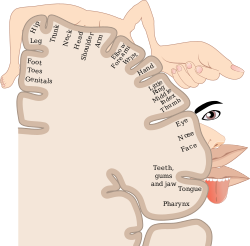This article needs additional citations for verification. (June 2017) |

A cortical homunculus (from Latin homunculus 'little man, miniature human'[1][2]) is a distorted representation of the human body, based on a neurological "map" of the areas and portions of the human brain dedicated to processing motor functions, and/ or sensory functions, for different parts of the body. Nerve fibres—conducting somatosensory information from all over the body—terminate in various areas of the parietal lobe in the cerebral cortex, forming a representational map of the body.
Findings from the 2010s and early 2020s began to call for a revision of the traditional "homunculus" model and a new interpretation of the internal body map (likely less simplistic and graphic), and research is ongoing in this field.[3]
- ^ "Definition of HOMUNCULUS". www.merriam-webster.com. Retrieved 6 February 2022.
- ^ "Homunculus | Meaning & Definition in UK English | Lexico.com". Lexico Dictionaries | English. Archived from the original on May 18, 2021. Retrieved 6 February 2022.
- ^ Scientific American Dosenbach, NUF; How our team overturned the 90-year-old metaphor of a 'little man' in the brain who controls movement, April 21, 2023